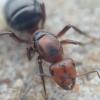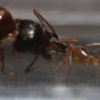I have a 3 queen and a 2 queen colony from earlier this year. They are still getting along fine, but I know someone who had a 2 queen colony from this year and recently (within this month) the workers dragged one queen into the outworld after attacking her. I'm not sure why they did this, because they had plenty of room (other tubes) to live in. I put the queens together right as I made the test tube setups. There was also a video that I saw earlier this year (made like 6 years ago though) of somebody merging several single queen Prenolepis imparis colonies (soon after they had their nanitics, so very young colonies). The tubes were just placed near each other and lots food was placed outside of the tubes (so they had a lot and wouldn't fight over a little I assume) and when the workers first met they would initially fight and then stop. Then they would return to their tubes, walk back out and touch antennae again, then eventually the workers began grabbing their own queen's brood and bringing it to one tube. Not longer after that, the queens moved to that same tube as well. It's, in my opinion, best to put them together before they lay eggs, so you aren't taking any chances, but its not impossible to merge while the colonies are still young. As for merging older colonies, I have no clue, but I hope this helped.
![]()


















